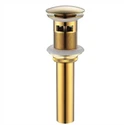Hey there! As a sink drain supplier, I've been getting tons of questions about how a sink drain trap works. So, I thought I'd break it down for you in this blog post.
First off, let's talk about what a sink drain trap is. You've probably seen it under your sink – it's that U-shaped pipe. This little guy plays a super important role in your plumbing system.


The main job of a sink drain trap is to prevent sewer gases from coming back up into your home. You know that nasty smell that can sometimes come from drains? Well, the trap stops that stinky air from getting into your living space. How does it do that? It holds a small amount of water in the U-bend. This water acts as a barrier, blocking the gases from passing through. Think of it as a little water seal that keeps the bad stuff out.
Now, let's dive into how water moves through the trap. When you turn on the faucet and water starts flowing down the sink, it has to pass through the trap. The water rushes in, pushing the existing water in the trap further along the pipe. Once the water has passed through the trap, the U-bend fills back up with water, maintaining that all - important seal.
But what happens when there's a blockage? Sometimes, debris like hair, soap scum, or food particles can get stuck in the trap. This can slow down the water flow or even stop it completely. When that happens, you might notice that your sink starts to drain slowly or that water is pooling in the sink. If you're dealing with a blockage, you can try using a plunger. Just place it over the drain and give it a few good pumps. The pressure created by the plunger can often dislodge the blockage and get the water flowing again.
If the plunger doesn't work, you might need to take a closer look at the trap. Most traps are designed to be easily removable. You can usually unscrew the nuts on either end of the trap and carefully take it apart. Once you've removed the trap, you can clean out any debris that's causing the blockage. Just be sure to have a bucket handy to catch any water that might spill out.
Now, let's talk about the different types of sink drain traps. One common type is the P - trap. It's called a P - trap because it looks like the letter "P" when you see it from the side. P - traps are widely used in residential plumbing and are great at preventing sewer gases from entering your home. Another type is the S - trap. S - traps were more commonly used in the past, but they're not as popular anymore because they can sometimes lose their water seal more easily, especially if there's a lot of water flow.
As a sink drain supplier, I offer a variety of products to meet your needs. For example, check out our Gold Pop Up Basin Waste. It's not only functional but also adds a touch of style to your sink. The Waste Basin Pop Up is another great option. It's easy to use and helps keep your sink draining smoothly. And if you have a sink with an overflow, our Wash Basin Waste With Overflow is the perfect choice.
If you're in the market for sink drains or have any questions about how they work, I'd love to hear from you. Whether you're a homeowner looking to upgrade your sink or a contractor working on a big project, I can provide you with the right products and advice. Don't hesitate to reach out for a chat about your specific needs and how we can work together to get the best sink drain solutions for you.
References
- "Plumbing for Dummies" by Roy Barnhart
- "The Complete Guide to Home Plumbing" by Reader's Digest





